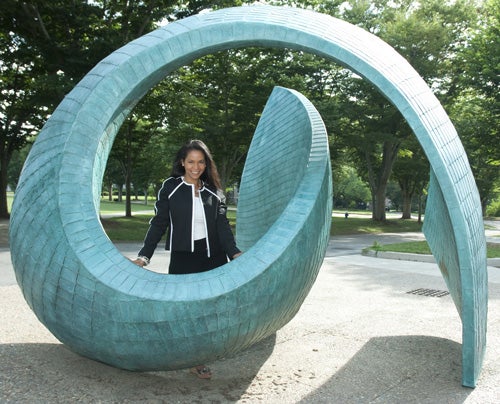Reversing the Trend

“Technology transfer is definitely a contact sport. It’s about connecting people and innovative technologies with market needs.”
In university and government laboratories across the country, brilliant scientific minds are developing technologies, systems, and a host of products.
However, most innovations never see the light of day. Government statistics prove that disappointing reality. According to the U.S. Department of Energy, only about 10 percent of 15,000 patents and patent applications held by their 17 national laboratories have been licensed for commercial use.
Aiming to reverse that trend is Karina Edmonds ’92, who was recently named the department’s first technology transfer coordinator. Though the position was approved by the Energy Policy Act of 2005, Edmonds was not appointed until last year: “The previous administration added the duties of the technology transfer coordinator to the role of the under secretary of science,” Edmonds explained. “Dr. Steven Chu, the current secretary of energy, recognized the need for a dedicated person to ensure we have a robust technology transfer program across the Department of Energy.
“I am extremely fortunate to have Secretary Chu’s full support in establishing policies that promote the effective and efficient transfer of knowledge, intellectual property, and capabilities developed at DOE labs to the private sector to create new products and services that bring additional benefits back to the American taxpayer.”
Edmonds, who majored in mechanical engineering at URI and went on to earn an M.S. and a Ph.D. in aeronautics from the California Institute of Technology, brings a wealth of experience to Washington.
At the time of her appointment, she was serving as director of the Technology Transfer Office at NASA’s Jet Propulsion Laboratory. In that environment, where scientists develop space-based telescopes and satellites, Edmonds enjoyed success in shepherding this complex technology beyond the confines of a laboratory: “People would be shocked to learn of all the incredible technologies that have had a big market and societal impact. In the area of imaging, JPL scientists had to build very small, lightweight, low-cost imagers to look for very faint objects far away in the universe. That same technology is now found in most cell phones with cameras.
“Another imaging technology based on a quantum well infrared photo detector (QWIP) sensor that detects very small temperature differences, has been applied to the early detection of breast cancer. On the bioscan system, cancer cells show up as a different color on the image because they emit more heat than normal cells due to their higher metabolic activity.”
At the root of Edmonds’ achievements is her ability to blend technical and interpersonal skills seamlessly: “Technology transfer is definitely a contact sport. It’s about connecting people and innovative technologies with market needs. I spent a lot of time at JPL building relationships with scientists and educating them about the importance of protecting their intellectual property.”
One of Edmonds’ biggest challenges is the sheer size of the U.S. Department of Energy. In addition to its 17 labs, the agency maintains plants and facilities that are also working with the private sector to move products to market.
Aiding Edmonds in her endeavors is the Technology Transfer Working Group with representatives from each DOE national laboratory and plant that have identified roadblocks to progress: “We are in the process of streamlining our contractual vehicles by removing outdated clauses and reducing the upfront payments—ranging between $10,000 to $50,000—that a company would need to license technologies from a lab. In the past, it could take more than six months to get on contract. We are working to reduce that to six to eight weeks. Clearly a very ambitious goal, but one that is worth pursuing because it is what our industry partners need.”
If ambition serves as the driver to efficiency and effectiveness, then Secretary Chu chose the ideal candidate to head the Technology Transfer office. Edmonds demonstrated an inherent desire to learn and succeed as a child when she arrived in the United States from the Dominican Republic. When she boarded the airplane, she thought, “How can this big chunk of metal stay in the air?”
Supportive teachers and the TIMES2 (To Improve Math, Engineering, and Science Studies) program designed to prepare minority children for careers in the sciences fueled her interest in how things worked.
Inspired by the engineers who gathered like-minded youths at TIMES2, Edmonds went on to serve as a catalyst bringing minority engineering students together when she helped found URI’s chapter of the National Society of Black Engineers: “I was inspired by a gathering at Brown University with a large group of minority engineering students—by large, I mean more than 20 students. Then I attended a National Society of Black Engineers conference in New York, and I was hooked. This was something that was definitely lacking at the time at URI; I thought it was a way to tap into a larger support network.”
Today Edmonds’ network is the Obama administration. She shares the president’s visions for promoting clean energy technology that correlates to job growth and for improving science literacy among the nation’s youth: “We need to figure out a way to keep students engaged in STEM [science, technology, engineering, and math] activities from an early age. Unfortunately, engineers and scientists are still not portrayed well on television, and as a result the perception is skewed. We are very well-rounded individuals who have an interest in making the world a better place through the pursuit of scientific knowledge.”
Given that Edmonds’ expertise has now transferred successfully from the lab to the Department of Energy, she is on the cutting edge of forging a clear path toward a greener nation and encouraging students—especially women and people of color as they remain largely underrepresented in STEM fields—to achieve that goal.
By Maria V. Caliri ’86, M.B.A. ’92
 Home
Home Browse
Browse Close
Close Events
Events Maps
Maps Email
Email Brightspace
Brightspace eCampus
eCampus


